Using a programmatic mapping approach to plan for HIV prevention and harm reduction interventions for people who inject drugs in three South African cities
- PMID: 28592246
- PMCID: PMC5463380
- DOI: 10.1186/s12954-017-0164-z
Using a programmatic mapping approach to plan for HIV prevention and harm reduction interventions for people who inject drugs in three South African cities
Abstract
Background: Stigma, criminalisation and a lack of data on drug use contribute to the "invisibility" of people who inject drugs (PWID) and make HIV prevention and treatment service delivery challenging. We aimed to confirm locations where PWID congregate in Cape Town, eThekwini and Tshwane (South Africa) and to estimate PWID population sizes within selected electoral wards in these areas to inform South Africa's first multi-site HIV prevention project for PWID.
Methods: Field workers (including PWID peers) interviewed community informants to identify suspected injecting locations in selected electoral wards in each city and then visited these locations and interviewed PWID. Interviews were used to gather information about the accessibility of sterile injecting equipment, location coordinates and movement patterns. We used the Delphi method to obtain final population size estimates for the mapped wards based on estimates from wisdom of the crowd methods, the literature and programmatic data.
Results: Between January and April 2015, we mapped 45 wards. Tshwane teams interviewed 39 PWID in 12 wards, resulting in an estimated number of accessible PWID ranging from 568 to 1431. In eThekwini, teams interviewed 40 PWID in 15 wards with an estimated number of accessible PWID ranging from 184 to 350. The Cape Town team interviewed 61 PWID in 18 wards with an estimated number of accessible PWID ranging between 398 and 503. Sterile needles were only available at one location. Almost all needles were bought from pharmacies. Between 80 and 86% of PWID frequented more than one location per day. PWID who reported movement visited a median of three locations a day.
Conclusions: Programmatic mapping led by PWID peers can be used effectively to identify and reach PWID and build relationships where access to HIV prevention commodities for PWID is limited. PWID reported limited access to sterile injecting equipment, highlighting an important HIV prevention need. Programmatic mapping data show that outreach programmes should be flexible and account for the mobile nature of PWID populations. The PWID population size estimates can be used to develop service delivery targets and as baseline measures.
Keywords: Formative assessment; HIV; Harm reduction; People who inject drugs; Population size estimation; Programmatic mapping; South Africa.
Figures
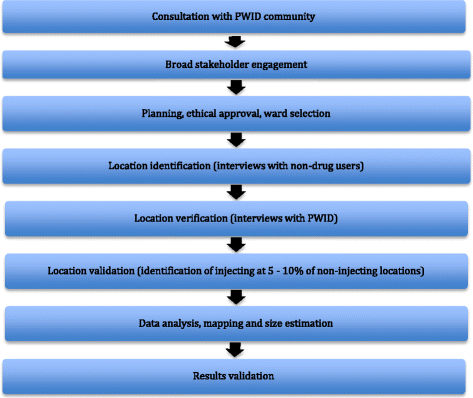
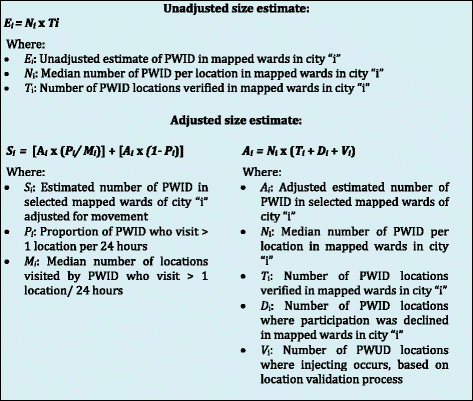
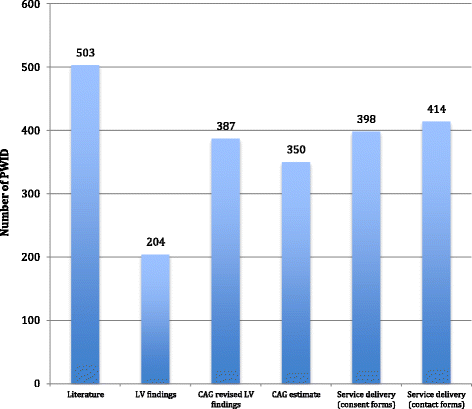
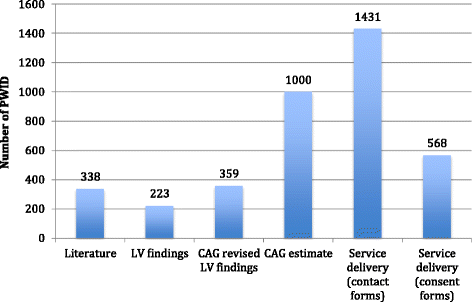
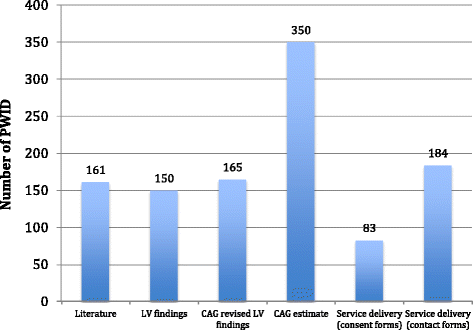
Similar articles
-
Access to and acceptability of sexual and reproductive health, harm reduction and other essential health services among people who inject drugs in Durban, South Africa.Harm Reduct J. 2024 Jun 26;21(1):123. doi: 10.1186/s12954-024-01042-6. Harm Reduct J. 2024. PMID: 38926755 Free PMC article.
-
"Until people start dying in droves, no actions will be taken": perception and experience of HIV-preventive measures among people who inject drugs in northwestern Russia.Harm Reduct J. 2017 Jun 5;14(1):33. doi: 10.1186/s12954-017-0162-1. Harm Reduct J. 2017. PMID: 28583120 Free PMC article.
-
Generating trust: Programmatic strategies to reach women who inject drugs with harm reduction services in Dar es Salaam, Tanzania.Int J Drug Policy. 2016 Apr;30:43-51. doi: 10.1016/j.drugpo.2016.01.012. Epub 2016 Jan 23. Int J Drug Policy. 2016. PMID: 26880500 Free PMC article.
-
Global coverage of interventions to prevent and manage drug-related harms among people who inject drugs: a systematic review.Lancet Glob Health. 2023 May;11(5):e673-e683. doi: 10.1016/S2214-109X(23)00058-X. Epub 2023 Mar 27. Lancet Glob Health. 2023. PMID: 36996860
-
Young people who inject drugs in Mozambique: should we emphasize them in the National Harm Reduction Plan?Harm Reduct J. 2020 Mar 26;17(1):20. doi: 10.1186/s12954-020-00363-6. Harm Reduct J. 2020. PMID: 32216809 Free PMC article. Review.
Cited by
-
Hepatitis B, hepatitis C and HIV prevalence and related sexual and substance use risk practices among key populations who access HIV prevention, treatment and related services in South Africa: findings from a seven-city cross-sectional survey (2017).BMC Infect Dis. 2020 Sep 7;20(1):655. doi: 10.1186/s12879-020-05359-y. BMC Infect Dis. 2020. PMID: 32894072 Free PMC article.
-
Population size, HIV prevalence, and antiretroviral therapy coverage among key populations in sub-Saharan Africa: collation and synthesis of survey data, 2010-23.Lancet Glob Health. 2024 Sep;12(9):e1400-e1412. doi: 10.1016/S2214-109X(24)00236-5. Lancet Glob Health. 2024. PMID: 39151976 Free PMC article.
-
A plea of those who are affected most by HIV: The utterances by women who inject Nyaope residing in the City of Tshwane Municipality, Gauteng.Afr J Prim Health Care Fam Med. 2021 Aug 16;13(1):e1-e9. doi: 10.4102/phcfm.v13i1.2416. Afr J Prim Health Care Fam Med. 2021. PMID: 34476973 Free PMC article.
-
Achieving meaningful participation of people who use drugs and their peer organizations in a strategic research partnership.Harm Reduct J. 2019 Jun 10;16(1):37. doi: 10.1186/s12954-019-0306-6. Harm Reduct J. 2019. PMID: 31182099 Free PMC article.
-
Modelling the impact of HIV and HCV prevention and treatment interventions for people who inject drugs in Dar es Salaam, Tanzania.J Int AIDS Soc. 2021 Oct;24(10):e25817. doi: 10.1002/jia2.25817. J Int AIDS Soc. 2021. PMID: 34661964 Free PMC article.
References
-
- National Department of Health, KwaZulu Natal Provincial Government, Central Drug Authority, UNODC, CDC, TB HIV Care Association et al. After 30 years the time for dealing with injecting drug use has finally come. Report from the Drug Use and HIV Preconference. Durban: National Department of Health, KwaZulu Natal Provincial Government, Central Drug Authority, UNODC, CDC, TB HIV Care Association; 2015.
-
- UNAIDS . UNAIDS Terminology Guidelines. Geneva: UNAIDS; 2015.
Publication types
MeSH terms
LinkOut - more resources
Full Text Sources
Other Literature Sources
Medical
Miscellaneous

